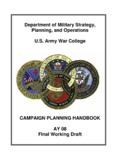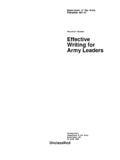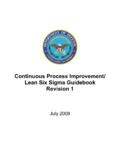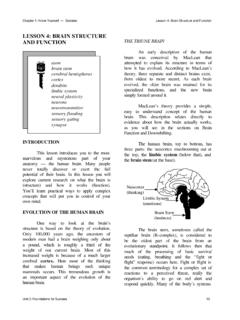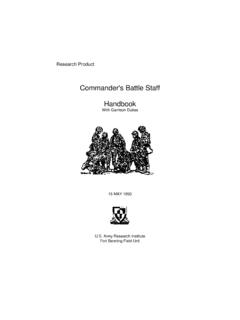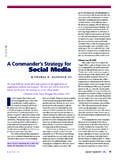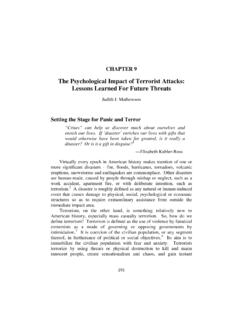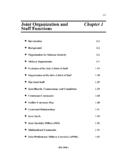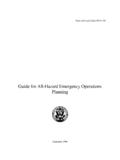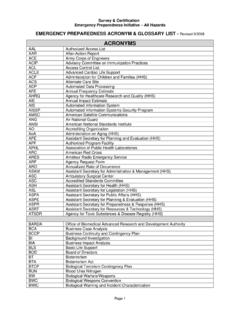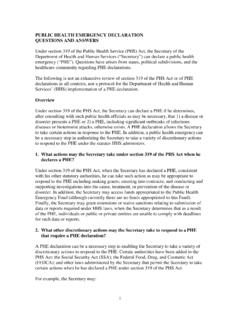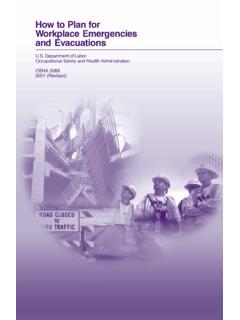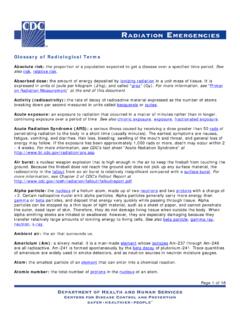Transcription of APPENDIX D Sample After Action Report - Air University
1 APPENDIX D. Sample After Action Report Sample After Action Report . Executive Summary The Executive Summary provides a brief overview of the exercise, major strengths demonstrated during the exercise, and areas that require improvement. Homeland security preparedness involves a cycle of outreach, planning, capability development, train- ing, exercising, evaluation, and improvement. Successful exercises lead to an ongoing program of process improvements. This Report is intended to assist agencies striving for preparedness excellence by analyzing exercise results and: Identifying strengths to be maintained and built upon. Identifying potential areas for further improvement. Recommending exercise followup actions. The suggested actions in this Report should be viewed as recommendations only. In some cases, agen- cies may determine that the benefits of implementation are insufficient to outweigh the costs.
2 In other cases, agencies may identify alternative solutions that are more effective or efficient. Each agency should review the recommendations and determine the most appropriate Action and the resources needed (time, staff, funds) for implementation. The Strategic National Stockpile (SNS; formerly the National Pharmaceutical Stockpile [NPS]) held a 2-day full-scale weapons of mass destruction (WMD) exercise June 17 18, 2003. The exercise was cosponsored by the State Department of Public Health (DPH) and the State Emergency Management Agency (EMA) with assistance from the Department of Health and Human Services, Centers for Disease Control and Prevention (CDC), and the Department of Homeland Security, Office for Domestic preparedness (DHS/ODP). This exercise was the State's first using newly developed pro- cedures to receive, distribute, and dispense SNS supplies in response to a statewide bioterrorism incident.
3 The exercise included CDC delivery of mock SNS supplies to a central receiving warehouse in the cap- ital city. The participating agencies coordinated the unloading, reapportionment, and distribution of those supplies to two actual and four simulated distribution points. The Capital County Public Health Department activated a temporary Dispensing Site and conducted emergency dispensing operations for 5 hours, treating 600 role-playing patients. Strengths Key strengths identified during this exercise include the following: The participants of all agencies at the State and local levels demonstrated excellent teamwork. A new cooperative partnership was established between DPH and EMA. The planning forethought demonstrated by State and local agencies in designing their SNS. receipt, distribution, and dispensing procedures was excellent. The participating agencies successfully demonstrated an initial capability to manage a statewide bioterrorism incident including the supply and operation of a temporary dispensing clinic.
4 D 1. The participants demonstrated a positive attitude and the ability to recognize and react to short- falls in the new SNS plans as they were uncovered and to smoothly adjust operations. In addition, several successes of this exercise should be recognized, among them: This was the first major DPH exercise. This was the first test of the State's new SNS Standard Operating Procedures. This was the first joint DPH/EMA exercise. This was one of the Nation's first exercises to comprehensively test SNS request, delivery, redistri- bution, and dispensing operations in a single, near-real-time exercise. In response to the quality, scope, and scale of the exercise, CDC provided three SNS training packages rather than the usual single package, and it piggybacked a no-notice CDC SNS deploy- ment exercise onto the State exercise. Areas for Improvement Through the exercise, several opportunities for improvement in the State's ability to respond to a bioterrorism incident were identified.
5 Major recommendations include the following: Electronic emergency management information system access and training should be expanded to all State agencies and all counties in the State. State quarantine plans and procedures should be reviewed and enhanced. Communication between the State and county Emergency Operations Centers and the tempo- rary SNS distribution network should be enhanced. Efficiency improvements should be made to the implementing procedures for the Receiving, Staging, and Storage (RSS) site and dispensing center. Improvements should be made to the dispensing center exterior security and to crowd control. Planners should use the results of this exercise to forecast dispensing and treatment center locations and staffing requirements for a large-scale bioterrorism event requiring implementation of mass pro- phylaxis. Planners should consider scenarios to serve 1,000; 10,000; 100,000; and 1 million patients for contagious or noncontagious threats.
6 Subsequent exercises should test specific improvements instituted as a result of this exercise and should include a focus on public information measures. Planners should consider exercising the alternate RSS. site should the primary site be unavailable in an emergency. Additional Dispensing Sites should be exer- cise to ensure that emergency prophylaxis measures can be instituted at key areas across the State. For cost effectiveness, planners should consider rotating Dispensing Site exercises across the State, with or without an SNS stockpile deployment exercise. D 2. Chapter 1: Exercise Overview The Exercise Overview describes the exercise, identifies the agencies/organizations that participated in it, and describes how it was structured and implemented. This information will be gathered in a database on the National Exercise Program and will be available for planning, scheduling, and evalua- tion purposes.
7 Exercise Name Strategic National Stockpile Tabletop and Full-Scale Exercise Duration 2 days Exercise Date June 17, 2003: Tabletop Exercise June 17 18, 2003: Full-Scale Exercise Sponsor Department of Homeland Security (DHS)/Office for Domestic preparedness (ODP). Type of Exercise Tabletop Exercise Full-Scale Exercise Funding Source (Agency Receiving Funding). State Emergency Management Agency Program Homeland Security Exercise and Evaluation Program, State 03 Funding Focus ___ Response X. ___ Recovery ___ Prevention ___ Other Classification ___ Unclassified (U). X For Official Use Only (FOUO). ___. ___ By Invitation Only (IO). Scenario ___ Chemical release or threat (C). X. ___ Biological release or threat (B). ___ Radiological release or threat (R). ___ Nuclear detonation or threat (N). ___ Explosive detonation or threat (E). D 3. ___ Cyber (Y). ___ Other/Specify (O). Location Anytown, US.
8 Participating Organizations Cosponsors Local Agencies County Emergency Management State Agencies State Department of Public Health State Emergency Management Agency Federal Agencies Department of Homeland Security, Office for Domestic preparedness Department of Health and Human Services, Centers for Disease Control and Prevention Contract Support (if applicable). (Name of Consulting Firm). Participants Federal Agencies Centers for Disease Control and Prevention Marshals Service State Agencies Attorney General's Office Bureau of Radiological Health Department of Agriculture Department of Personnel Department of Public Health Department of Public Safety Department of Transportation National Guard Emergency Management Agency Department of Health and Human Services D 4. Local Agencies Capital City Fire Department Capital City Police Department Capital City Public School District Capital County Health Department Suburban County 1 Health Department Suburban County 2 Health Department Capital County Air Quality Division Capital County Department of General Services Capital County Emergency Management Agency Capital County Health Department Capital County Sheriff's Office Suburban County 1 Emergency Management Agency Suburban County 1 Fire Department Suburban County 2 Emergency Management Agency Suburban County 2 Department of Public Health Other organizations Various county public health department and hospital volunteer role players American Red Cross Downtown pharmacy Central pharmacy State Board of Medical Examiners State Board of Pharmacy Examiners State Motor Truck Association State Pharmacy Association State Veterans Affairs State Visiting Nurse
9 Services Capital City Hospital Central Medical Center Capital County Health Advisory Board Capital County Medical Society Private Business Partners University Hygienic Laboratory D 5. International Agencies None Number of Participants Players 136. Victim role players 100. Controllers 28. Evaluators 28. Observers 89. Exercise Overview The Strategic National Stockpile (SNS) Full-Scale Exercise was designed to be a 2-day terrorism exer- cise. The goal of the exercise was to familiarize the necessary agencies with the protocols in place for deploying SNS supplies. Exercise play focused on the logistics associated with ordering, delivering, dis- tributing, and dispensing SNS supplies. The exercise was designed to: 1. Continue to solidify the partnership between the State and the Federal Government. 2. Assess the inter/intraagency coordination of Federal agencies, the State, and local jurisdictions during a public health crisis triggered by a terrorist attack using weapons of mass destruction (WMD).
10 3. Improve the operational readiness of the State emergency management system, and augment the capabilities of that system to respond to emergency situations. 4. Provide an opportunity for individual training and agency cross-training to achieve a high level of collective preparedness . 5. Assist the State in assessing, validating, and updating the State's Emergency Operations Plan (August 1999) and its Terrorism Incident Response Annex (January 2003), the State Emergency Operations Center Standard Operating Procedures (May 2000), and the SNS Standard Operating Procedures (March 2003). 6. Revisit and validate some of the lessons learned during the State's SNS Tabletop Exercise of January 2003. Participants were advised that the exercise was an evaluated practice, a format that allowed players to test their plans and procedures within a no-fault learning environment. At the same time, Evaluators, Controllers, and Simulators collected information to assess performance of critical tasks during exer- cise play using State and local plans and procedures.
